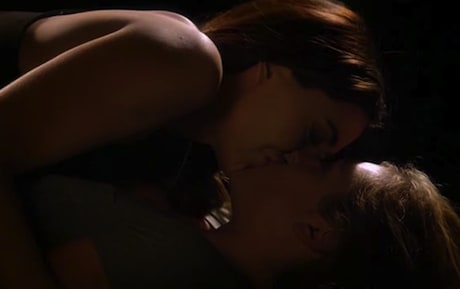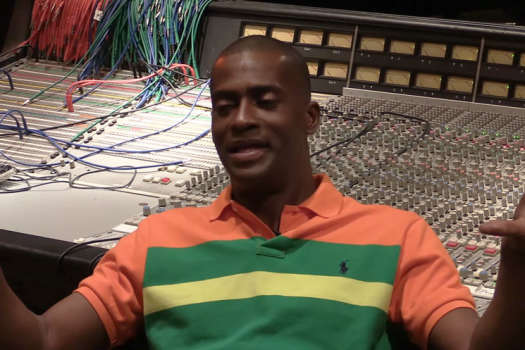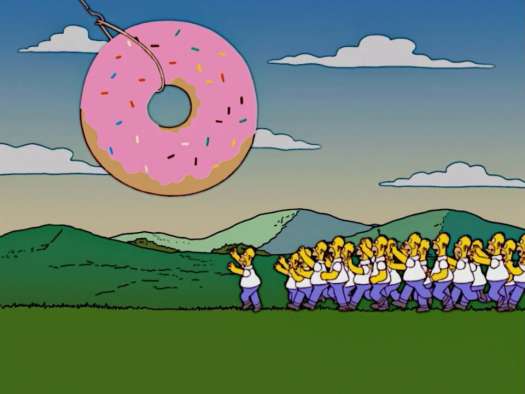Knowing that director Jamie Babbit was behind the atmospheric, exceedingly cerebral and surprisingly moving psychological thriller, The Quiet, makes the opening scenes of the seemingly far more literal and flat Breaking the Girls that much more confounding.
As scholarship student Sara Ryan (Agnes Bruckner) is established as a promising law student, working at a campus pub when not wooing classmate Eric (Shawn Ashmore), there's a shoddy sensibility to it all that suggests a rushed production or a first time filmmaker. The dialogue is clumsy and repetitive and the aesthetic tacky, which is particularly evident when Alex (Madeline Zima) is introduced, walking into Sara's bar in pseudo-dominatrix garb, ordering a jack and coke, playing victim to Sara's saviour when a meathead boy makes a really strained, unbelievable pass at her.
But amidst these early scenes and the eventual, oddly performative and cold, sexual relationship between Alex and Sara, there are telling signs that there's more to this standard erotic thriller template than meets the eye. Sara's body language and behaviour shifts depending on who she's with. When with Alex, she's masculine, hard and confident, but when she's with Eric, she's more passive, listening eagerly to his advice and bashfully hinting at a bigger relationship.
The sexualisation of lesbian experimentation and eventual conflict between Sara and fellow classmate Brooke (Shanna Collins)—over Eric—is almost too formulaic and sexist to be believable, which, knowing the texts that Babbit and writer Guinevere Turner typically sink their teeth into, is a safe bet. This is why the eventual murder plot concocted by Alex—one that manipulates the inherently male institution of law by evading motive—suggests that the staginess of everything preceding might have something to do with the mystery of it all.
Alex suggests that she will kill Brooke if Sara will, in turn, off her mother-in-law and ex-lover Nina (Kate Levering). Other tells amidst the series of interactions between all of these players about murder and sexual desire similarly implies this thriller template exists as a shell for a gender play. And once things start to fall into place, the tongue-in-cheek mockery of heteronormative performance and the different approaches that men and women take to inherently male institutions, such as judicial systems and marriage, starts to become clear.
It's just unfortunate that the overall lack of polish doesn't differentiate performance from reality with enough visual aplomb to sell it all. Babbit, who is capable of establishing a tone and visceral experiential component, makes things deliberately cold to avoid showing her hand. As such, there's no Mulholland Drive division in the narrative to make clear the intentions after the fact, making it seem as though the dodgy television movie structure was simply incompetence.
More care and patience in handling moments not intended to be as they appear could have easily remedied this problem—along with a brief rewrite to get rid of some unnatural purple prose or archetypal characterizations—making Breaking the Girls the sort of ironic and compelling trashy early '90s throwback it intends to be. It still does work for what it is but the audience is limited to those interested in reading a text in relation to the cultural climate and genre tropes, rather than embracing a bigger audience that might have enjoyed the many plot twists and mind-fuck of it all despite not having the education to understand what Turner and Babbit are getting at.
Of course, knowing that this was filmed in Serbia means that these hiccups might simply have to do with having a less than communicative and cooperative crew on hand.
(IFC)As scholarship student Sara Ryan (Agnes Bruckner) is established as a promising law student, working at a campus pub when not wooing classmate Eric (Shawn Ashmore), there's a shoddy sensibility to it all that suggests a rushed production or a first time filmmaker. The dialogue is clumsy and repetitive and the aesthetic tacky, which is particularly evident when Alex (Madeline Zima) is introduced, walking into Sara's bar in pseudo-dominatrix garb, ordering a jack and coke, playing victim to Sara's saviour when a meathead boy makes a really strained, unbelievable pass at her.
But amidst these early scenes and the eventual, oddly performative and cold, sexual relationship between Alex and Sara, there are telling signs that there's more to this standard erotic thriller template than meets the eye. Sara's body language and behaviour shifts depending on who she's with. When with Alex, she's masculine, hard and confident, but when she's with Eric, she's more passive, listening eagerly to his advice and bashfully hinting at a bigger relationship.
The sexualisation of lesbian experimentation and eventual conflict between Sara and fellow classmate Brooke (Shanna Collins)—over Eric—is almost too formulaic and sexist to be believable, which, knowing the texts that Babbit and writer Guinevere Turner typically sink their teeth into, is a safe bet. This is why the eventual murder plot concocted by Alex—one that manipulates the inherently male institution of law by evading motive—suggests that the staginess of everything preceding might have something to do with the mystery of it all.
Alex suggests that she will kill Brooke if Sara will, in turn, off her mother-in-law and ex-lover Nina (Kate Levering). Other tells amidst the series of interactions between all of these players about murder and sexual desire similarly implies this thriller template exists as a shell for a gender play. And once things start to fall into place, the tongue-in-cheek mockery of heteronormative performance and the different approaches that men and women take to inherently male institutions, such as judicial systems and marriage, starts to become clear.
It's just unfortunate that the overall lack of polish doesn't differentiate performance from reality with enough visual aplomb to sell it all. Babbit, who is capable of establishing a tone and visceral experiential component, makes things deliberately cold to avoid showing her hand. As such, there's no Mulholland Drive division in the narrative to make clear the intentions after the fact, making it seem as though the dodgy television movie structure was simply incompetence.
More care and patience in handling moments not intended to be as they appear could have easily remedied this problem—along with a brief rewrite to get rid of some unnatural purple prose or archetypal characterizations—making Breaking the Girls the sort of ironic and compelling trashy early '90s throwback it intends to be. It still does work for what it is but the audience is limited to those interested in reading a text in relation to the cultural climate and genre tropes, rather than embracing a bigger audience that might have enjoyed the many plot twists and mind-fuck of it all despite not having the education to understand what Turner and Babbit are getting at.
Of course, knowing that this was filmed in Serbia means that these hiccups might simply have to do with having a less than communicative and cooperative crew on hand.




